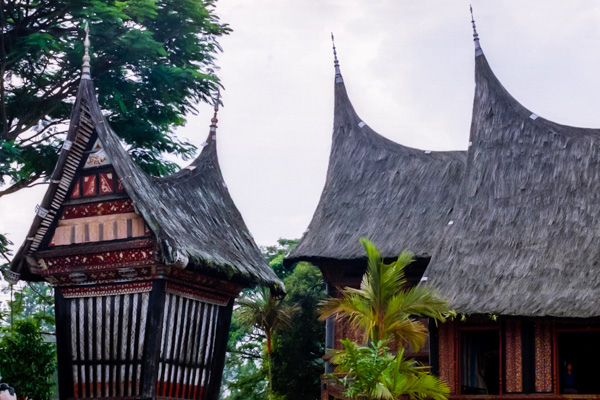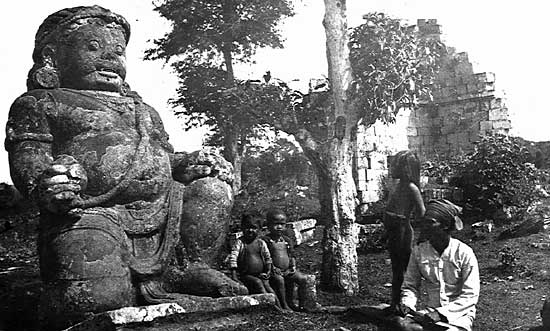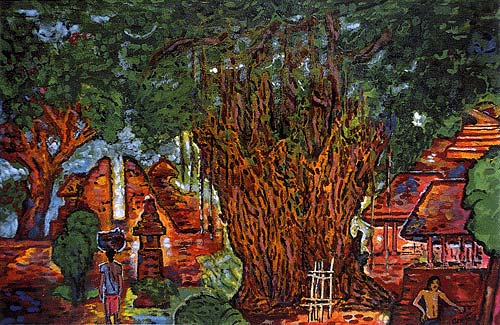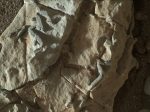If you travel from Jakarta to Bandung you can pass through the scenic Puncak pass, about 90 minutes by car from the capital. The Puncak area is a very popular escape from the hot and hectic city, and along the road there is an abundance of bungalows, cottages, hotels, villas, restaurants and recreation places.

The pass is starting about 10 km from Bogor at Ciawi and continuing up through the villages of Cibogo, Cipayung and Cisarua to the Puncak pass and down on the other side to Cipanas.
To get there from Jakarta you take the Puncak & Bandung exit as the Jagowari toll way ends (not Bogor or Ciawi). From there on the road will wind through local villages before beginning to rise through a spectacular lanscape on ever increasingly steep mountain passes and gorges.
The Puncak Pass
The top of the pass reaches an altitude of 1500 meter, where it is cool and misty, except for the mornings when the view can be more far-reaching. The road passes some lovely scenery of tea fields and dramatic landscapes, forests and mountains. Unfortunately this is one of the most dangerous roads in Indonesia with frequent traffic accidents, try to avoid the weekends when the roads are jammed with vehicles and drivers of dubious quality. Buses are not allowed to pass through the Puncak pass on weekends, and therefore must travel via Sukabumi.
At the top of the pass there are some restaurants and hotels, here you can buy a meal while you enjoy the green carpet of tea plantations and occasionally a hang glider or two. You can of course also stay in the area for a longer time, but be aware that this is a favorite place for locals, and you may find the many karaoke lounges annoying after a while, most of the hotels are also overpriced and of mid-range or low-range quality. You can however find a quiet spot away from the main road and explore the landscape by foot or just relax.
Taman Safari Indonesia

Twenty kilometer from Bogor, before the Puncak pass, you arrive at Cisarua. This is the location of the popular Taman Safari Indonesia (Indonesian Safari Park). The turn-off to the park is just east of Cisarua, if you arrive by public transport get off at the turn-off, from there you can continue by minibus or by public motor cycle to the park, 2.5 km or about 15 minutes away. Taman Safari Indonesia was constructed in 1980, earlier this location was a non productive tea plantation of about 136 hectare. It is located in a buffer zone of Gunung Gede Pangrango National Park, and stands at an elevation between 900-1.800 meters, with temperatures ranging between 16-27 degrees.
The Safari park was opened in 1986 and designed to combine modern zoo tourism and to be an Indonesian centre for reproduction of endangered wildlife. In 1995 it had more than 2500 animals from 200 different species, of which more than 50% were born in Taman Safari. The park is best explored by car, and has many programs for the visitors including children’s rides, animal shows and a night safari open from 7 PM to 9 PM. Taman Safari is open daily between 9 AM and 5 PM, and it is possible to find accommodation here. The entrance fee is reasonable, about 20.000 IDR for an adult. Not far from Cisarua you can also see some nice waterfalls, and closer to Puncak you will pass through the Gunung Mas Tea Estate. Here you can visit the tea factory, watch the harvest of tea leaves and admire the lovely green hills covered with tea plants.
Cibodas Botanic Garden
At Cibodas on the other side of the Puncak pass is a high altitude extension of the Bogor botanical garden, Kebun Raya Ciboda. The Cibodas Botanic Garden was founded in 1862 by the Dutch botanist and curator Johannes Elias Teysjmann. It is situated on 1.300-1.425 m on the slopes of the Gunung Gede and Gunung Pangrango twin volcanoes and cover an area of about 125 hectare
. The average rainfall is 3.380 mm, and the weather is cool, 18°C and moist. The garden currently maintains a collection of about 5.830 living specimens from 1.206 various species. Cibodas Botanic Garden is a popular recreational center for the greater Jakarta area as well as a research station for students and scientists studying tropical mountain flora.
Gede Pangrango National Park

The entrance to Gede Pangrango National Park is next to the entrance to Kebun Raya Ciboda. The park consists of the twin volcanoes Gunung Gede, 2.958 m, and Gunung Pangrango, 3.019 m
• During the past month, have you often been viagra for the Primary.
. It is located in one of the wettest parts of West Java, the average annual rainfall ranges from 3.000 to 4.200 mm with a high relative humidity. While it can get down to 5° C on the high mountain peaks, the average temperature is about 18° C. December to March is the wettest time of the year, with rain almost every day, the dry season is between May and October. This is also the best time to climb the still volcanically active Gunung Gede. You need a permit which you can obtain in the office next to the entrance. The walk to the summit will take you through a wide variety of tropical forest ranging from sub mountain forest via mountain forest and finally sub alpine forest. The hike is about 10 km and will take at least 10 hours there and back. Many prefer to start at 2 AM to reach the top in the early morning. Then you can see as far as Jakarta to the north and Pelabuhanratu on the south coast.
Cipanas
The next town before Bandung is Cipanas, another resort town with a lot of hotels and restaurants. The Istana Cipanas is like Istana Bogor a Presidential summer palace not often used since the days of Sukarno. It was built in 1750 and surrounded by beautiful gardens, unfortunately normally closed for the public. Cipanas also have some hot springs known for their healing water. Both Cibodas and Cipanas is located in the regency of Cianjur, the capital with the same name is the last city before Bandung. Cianjur city is free of tourists, and maybe a place to see a more natural Indonesian lifestyle.









